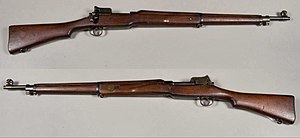Pattern 1914 Enfield
| Rifle, .303 Pattern 1914 | |
|---|---|

Pattern 1914 Enfield
|
|
| Type | Service rifle |
| Place of origin | United Kingdom |
| Service history | |
| Used by | See Users |
| Wars |
World War I World War II |
| Production history | |
| Designed | 1914–15 |
| No. built | 1,235,298 total |
| Variants | Sniper (telescopic and unmagnified), grenade launcher, US M1917 rifle |
| Specifications | |
| Weight | 9 lb 6 oz (4.25 kg) unloaded |
| Length | 46.25 in (1,175 mm) |
| Barrel length | 26 in (660 mm) |
|
|
|
| Cartridge | .303 British |
| Action | Modified Mauser turn bolt-action |
| Rate of fire | Manual, as determined by skill of operator |
| Muzzle velocity | 2,380 ft/s (725 m/s) |
| Effective firing range | 800 yd (732 m) |
| Feed system | 5-round, charger reloading |
The Rifle, .303 Pattern 1914 (or P14) was a British service rifle of the First World War period. A bolt action weapon with an integral 5-round magazine, it was principally contract manufactured by companies in the United States. It served as a sniper rifle and as second line and reserve issue until being declared obsolete in 1947. The Pattern 1914 Enfield was the successor to the Pattern 1913 Enfield experimental rifle and the predecessor of the U.S. Rifle M1917 Enfield.
During the Boer War the British were faced with accurate long-range fire from Mauser rifles, model 1893 and 1895, in 7×57mm caliber. This smaller, high-velocity round prompted the War Department to develop their own "magnum" round, the .276 Enfield, in 1910. An advanced new rifle using a modified Mauser M98-pattern action was built to fire it, the Pattern 1913 Enfield (P13); effective mass production was still some way off when World War I started, to say nothing of the logistical nightmare of introducing a new rifle cartridge in wartime, so nothing came of it.
The primary contractor (Vickers) was unable to produce more than a handful of rifles, so the P14 became a de facto afterthought. The Short Magazine Lee–Enfield therefore remained the standard British rifle during World War I and beyond.
The need for additional small arms combined with a shortage of spare industrial capacity led the British government to contract with U.S. commercial arms manufacturers, Winchester, Remington and Eddystone (a subsidiary of Remington set up principally to manufacture the P14) to produce the P14 for the British before the US entered the war in 1917. Problems were encountered with specifications, quality and shortage of machine tools and skilled workers, with the result that the first rifles were not accepted by British inspectors until February 1916. Shortly afterwards a modification was made to enlarge the bolt lugs and the rifle became the Mark I*. However, each factory produced slightly differing parts, leading to interchangeability issues; Winchester was particularly troublesome in this regard, going so far as to refuse for months to change to the new Mark I* standard. Therefore, the official designation of the rifle was dependent upon its manufacturer: e.g., the Pattern 1914 Mk I W and Pattern 1914 Mk I* W is a Mk I or Mk I* of Winchester manufacture, R would be Remington, or E for Eddystone.
...
Wikipedia
